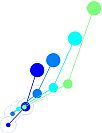The desert locust, Schistocerca gregaria, has been known for remarkable behavioral plasticity, transitioning between solitary and gregarious phases in response to population density and environmental factors. This study investigates the influence of habitat structure on the development of social phenotype in locusts, focusing on how resource distribution shapes behavior along time. We compared two habitat structures - a centralized and distributed - to assess foraging patterns, activity levels, and social interactions. Using motion-capture technology and advanced video tracking tools, we monitored locust behavior continuously for 21 days to quantify distance walked, speed, and social proximity. Phenotypes at the end of the experiment were further assessed in subsequent behavioral assays comparing response to conspecifics in an unstructured environment. In parallel, molecular investigations were performed to shed light on potential brain wide molecular mechanisms underlying these behavioral changes. For that, locust brains were collected at defined time points throughout the experiment for RNA analysis. Our preliminary results reveal that locusts raised in a centralized habitat exhibited a higher degree of gregarious behavior, while those in distributed habitat structures displayed more solitary behavior. These findings were consistent across both individual and group-level behavioral assays, suggesting that habitat structure significantly influences social phenotype development in desert locusts. Additionally, RNA Sequencing analysis of the locust brains indicated alterations in gene expression associated with these behavioral changes, highlighting the neural and genetic mechanisms that underpin the observed phenotypic differences. Our study underscores the critical role of environmental factors in shaping locust behavior and offers insights into the adaptive strategies of this species in response to habitat variations. It opens up the potential to investigate the neural circuit mechanisms underlying environmentally induced behavioral changes.
Keywords: Long-term behavioral assay, Behavioral Plasticity, RNA Sequencing, Desert Locust.

 PDF version
PDF version
